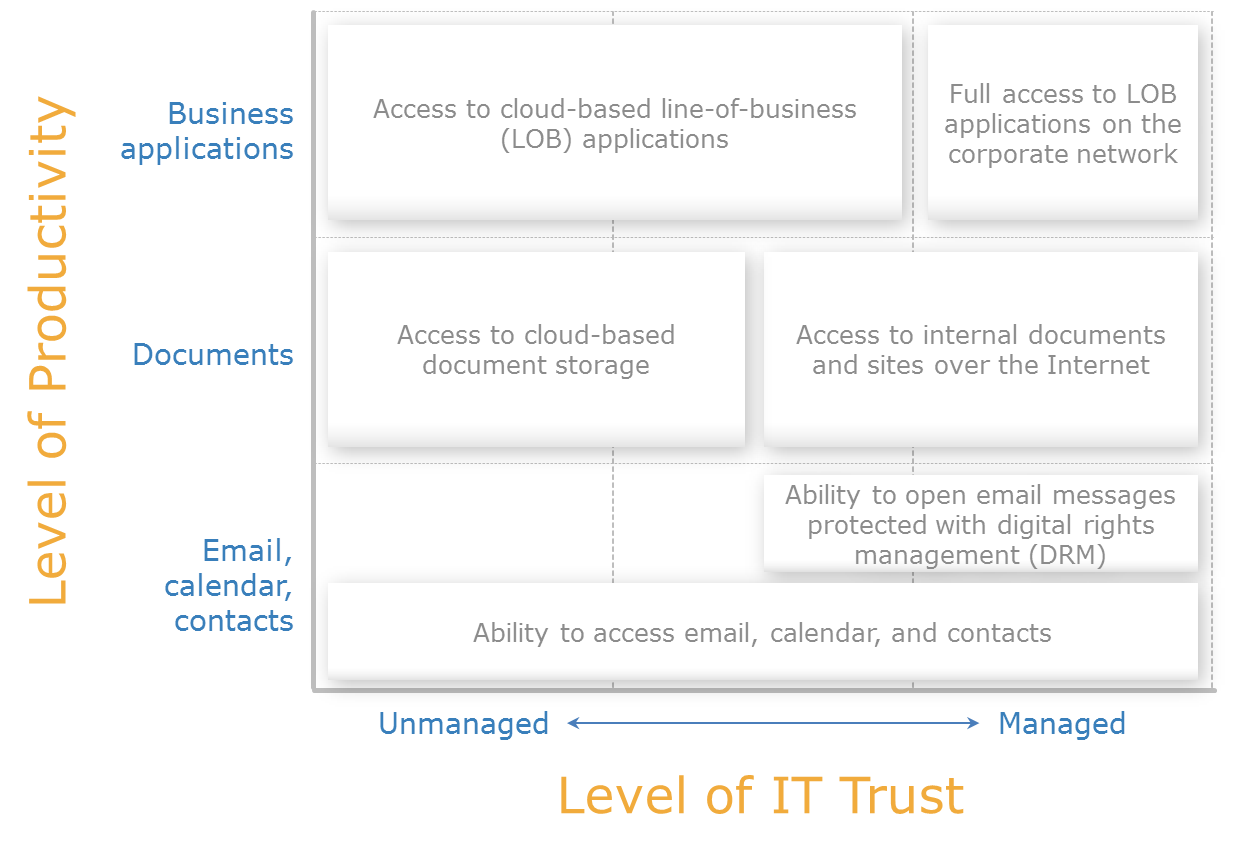The Next Level of Productivity
Originally published on the Microsoft CIO Network. Join today.
Thinking back to CES in Las Vegas, one of the things that stood out was the tremendous increase in choice for consumers when it comes to accessing and consuming information. There is the promise of “healthy” competition in the foreseeable future, bringing with it the fact that IT will have to brace itself for an even greater number of employees wanting to choose for themselves which tools to work with. As with most decisions, IT can respond in one of three ways: Forbid, Ignore or Support.
Forbid
The “forbidding” strategy (not allowing any device to connect or be used that isn’t centrally managed / requisitioned) is nearly impossible to enforce but is guaranteed to cause emotional discussions with users on why they can’t work the way they want to—so let’s not delve into this further.
Ignore
“Ignoring” the situation is a popular move right now—let users figure it out and, if it works, great! If not, we’re not investing in supporting their personal equipment. It’s a valid point but it doesn’t help in the long run because people will spend more and more time tinkering—sometimes deliberately circumventing security policies in order to “make things work.”
Support
That leaves us with the “Support” option—something that I would describe as being carefully supportive by establishing a “standard” set of interfaces and policies that allow a variety of devices to connect. Take ActiveSync for example: ActiveSync allows email and calendar synchronization between a mobile device and a Microsoft Exchange Server. There are clients available for Android, Apple’s iOS, Nokia, Windows Phone 7 and others (except, of course, RIM as they have their own synchronization method).
ActiveSync allows you to set a number of policies like Encryption, Device Wipe, etc.—IT can therefore establish and enforce a policy that requires any connecting client to support a minimum set of security policies which in turn allows any client with those capabilities (regardless of OS!) to synchronize with the Server.
Enabling Productivity
When we talk about “enabling Productivity,” I would like to differentiate among several levels of productivity and integration. At the bottom—or the most basic productivity level—we have email and calendar availability and synchronization. It is what most people would describe as “must-have” on their device.

Documents
The very next challenge is accessing and working on documents when not at your desk or connected to the corporate network. These days, a lot of people keep email content to themselves so they can continue to work on it while away from the office—or they just move it to a cloud-based file share like Microsoft SkyDrive.
This approach comes with a number of problems. For one, the content is moved outside of the corporate network—it’s in the open, most likely unprotected, and is easily saved or “accidentally distributed” to places where it shouldn’t go.
In addition, if the document was originally on a file share, no one else can work on it without creating different versions that will need to be consolidated later—resulting in a productivity loss that is equal or greater to what was achieved initially by working on it offline.
So how can we provide a secure way to access documents without corporate network connectivity or full-fledged VPN access? Those of you who use Windows Phone 7 will know that it contains a SharePoint Client. Together with ForeFront UAG, it allows direct access to SharePoint servers inside the firewall. So accessing a document from a mobile device will be secure (no more emailing content outside the company) and consistent (allowing the most recent version to be accessed—no offline files containing different versions of the content).
Today, Windows Phone 7 is the only mobile OS with a native SharePoint client but—and I’m going out on an limb here with no data to back this up—there is nothing to say that there shouldn’t be other clients for other OSs that would allow this.
Applications
The next step for productivity is Applications—productivity applications that let you view and edit standard documents like Word, Excel or PowerPoint as well as Line of Business applications, giving you access to CRM or ERP data. This is probably the least developed sector of mobile productivity to date and I expect the first wave to be web applications that are formatted for mobile devices—allowing development for a variety of operating systems without having to provide a native application for every device and every version.
I’ll be talking about this more as the space evolves and more solutions are introduced. In the meantime, I would love to hear your comments.
The opinions and views expressed in this blog are those of the author and do not necessarily state or reflect those of Microsoft.